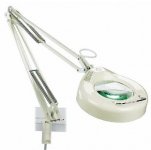So I have been doing a lot of small trace repair as of late. And I can tell the strain on my eyes is pretty severe. Its giving me headaches and other fatigue. after a couple hours of staring at PCBs close up I find I have trouble focusing on anything else for a couple houses afterwards. I had Lasik done 18 years ago and it was one of the best choices I ever made but as things happen even that cant help with this type of work and getting older.
Mick
One thing to consider is that it takes time for you to develop the symptoms. The inner working of the eye itself are super stable (one caveat on that remark see below), but the outer surface is not stable always.
When we concentrate on a task, the spontaneous or involuntary blinking rate drops to a low value and there is more evaporation of the tear film.
The tear film is actually a complex 3 layer structure, the surface of the eye is hydrophobic, so a mucin layer made by conjunctival goblet cells binds to the corneal surface cells, that layer hydrophobic on one side and hydrophilic on the other, binds to the salt water layer of the tears, this is made by the lacrimal gland in the super-temporal orbital area. This salt water layer forms the bulk of the tear film thickness. Then floating on top of the tear film, is a thin oil layer (like an oil slick floats on seawater). This oil is made by oil glands called meibomian glands, that are in the eyelids. There are small holes just behind where the eye lashes come out of the skin. All the three tear layers have to be in good order, or the eye can dry out very quickly, especially while concentrating, with reduced blinking and especially with low relative humidity too.
Once the dried areas on the corneal surface occur, it causes visual blur, often eye discomfort and the dried areas are difficult to re-wet for a while.
Generally, there is a feedback loop, in that as the corneal sensory nerves detect drying, it increases the lacrimal gland output. This loop is not as effective after Lasik, because many corneal nerves were cut at the time the flap was made and they don't fully regenerate. In young people with an abundant tear film its usually not an issue, but in older people dry eye contraindicates a Lasik procedure for this reason.
However, as we age the lacrimal gland output drops, and the oil glands in the eyelids start to produce less effective thicker or abnormal oil and its called meibomian gland dysfunction.Various treatments are available, including intense pulse light and meibomian gland expression (just hot compresses work well in most cases)
A simple test at the optometrist(Or Ophthalmologist) is the tear film break up time, by looking at the microscope, asking the person not to blink and seeing how long it takes for the tear film layers to destabilize. Another test (Shirmer's) measures the output from the lacrimal gland over time.
So it is the case that many symptoms that people call "eye strain" are in fact various versions of dry eye, especially if they start up 10 or 20 minutes after starting concentrating on a visual task. The headaches are often secondary to neck posture issues.
The eye of course is a transducer and it can no more strain itself to see something than a microphone can strain itself to hear something.
There is a caveat of course. In our late 40's (but the the timing is variable) we develop Presbyopia. This is a failure of the dynamic range of the eye's auto-focus mechanism involving the ciliary muscle and the natural lens in the eye, so the ability for the focus to correct for an object near to the eye progressively decreases and people find they have to hold the object further away from their face to focus on it until "their arms are not long enough". The solution, generally, is reading or near glasses. There can sometimes be a spasm of the ciliary muscle after prolonged attempts at near work when the auto-focus mechanism is on its lasts legs, which results in a near focal shift that takes a while to wear off after periods of concentration (called accommodative spasm), but normally this does not happen if near glasses are used as it relaxes the system. So if you have become presbyopic and are not using near glasses, this is another explanation for your symptoms.
One thing you could do is visit an optometrist and get them to look at the meibomian gland output, pressing on them and looking at the oil at the slitlamp microscope can be helpful. If it is abnormal then hot compresses with a warm face washer cloth and pressure can help improve the quality of the oil. And maybe look at the tear break up time.
Another thing is, you could try pre-lubricating your eyes a few minutes prior to near work with artificial tears from the pharmacy, Systane Ultra is a good product. Then if you have been working for an hour, have a break and add an additional drop to each eye. These drops do not have any drugs in them so you cannot over do it. Most people who use drops for dry eyes barely use enough.

